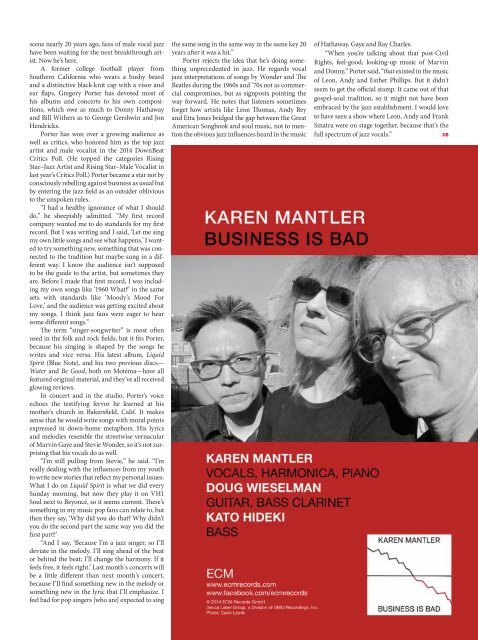You also want an ePaper? Increase the reach of your titles
YUMPU automatically turns print PDFs into web optimized ePapers that Google loves.
scene nearly 20 years ago, fans of male vocal jazz<br />
have been waiting for the next breakthrough artist.<br />
Now he’s here.<br />
A former college football player from<br />
Southern California who wears a bushy beard<br />
and a distinctive black-knit cap with a visor and<br />
ear flaps, Gregory Porter has devoted most of<br />
his albums and concerts to his own compositions,<br />
which owe as much to Donny Hathaway<br />
and Bill Withers as to George Gershwin and Jon<br />
Hendricks.<br />
Porter has won over a growing audience as<br />
well as critics, who honored him as the top jazz<br />
artist and male vocalist in the 2014 DownBeat<br />
Critics Poll. (He topped the categories Rising<br />
Star–Jazz Artist and Rising Star–Male Vocalist in<br />
last year’s Critics Poll.) Porter became a star not by<br />
consciously rebelling against business as usual but<br />
by entering the jazz field as an outsider oblivious<br />
to the unspoken rules.<br />
“I had a healthy ignorance of what I should<br />
do,” he sheepishly admitted. “My first record<br />
company wanted me to do standards for my first<br />
record. But I was writing and I said, ‘Let me sing<br />
my own little songs and see what happens.’ I wanted<br />
to try something new, something that was connected<br />
to the tradition but maybe sung in a different<br />
way. I know the audience isn’t supposed<br />
to be the guide to the artist, but sometimes they<br />
are. Before I made that first record, I was including<br />
my own songs like ‘1960 What?’ in the same<br />
sets with standards like ‘Moody’s Mood For<br />
Love,’ and the audience was getting excited about<br />
my songs. I think jazz fans were eager to hear<br />
some different songs.”<br />
The term “singer-songwriter” is most often<br />
used in the folk and rock fields, but it fits Porter,<br />
because his singing is shaped by the songs he<br />
writes and vice versa. His latest album, Liquid<br />
Spirit (Blue Note), and his two previous discs—<br />
Water and Be Good, both on Motéma—have all<br />
featured original material, and they’ve all received<br />
glowing reviews.<br />
In concert and in the studio, Porter’s voice<br />
echoes the testifying fervor he learned at his<br />
mother’s church in Bakersfield, Calif. It makes<br />
sense that he would write songs with moral points<br />
expressed in down-home metaphors. His lyrics<br />
and melodies resemble the streetwise vernacular<br />
of Marvin Gaye and Stevie Wonder, so it’s not surprising<br />
that his vocals do as well.<br />
“I’m still pulling from Stevie,” he said. “I’m<br />
really dealing with the influences from my youth<br />
to write new stories that reflect my personal issues.<br />
What I do on Liquid Spirit is what we did every<br />
Sunday morning, but now they play it on VH1<br />
Soul next to Beyoncé, so it seems current. There’s<br />
something in my music pop fans can relate to, but<br />
then they say, ‘Why did you do that? Why didn’t<br />
you do the second part the same way you did the<br />
first part?’<br />
“And I say, ‘Because I’m a jazz singer, so I’ll<br />
deviate in the melody. I’ll sing ahead of the beat<br />
or behind the beat; I’ll change the harmony. If it<br />
feels free, it feels right.’ Last month’s concerts will<br />
be a little different than next month’s concert,<br />
because I’ll find something new in the melody or<br />
something new in the lyric that I’ll emphasize. I<br />
feel bad for pop singers [who are] expected to sing<br />
the same song in the same way in the same key 20<br />
years after it was a hit.”<br />
Porter rejects the idea that he’s doing something<br />
unprecedented in jazz. He regards vocal<br />
jazz interpretations of songs by Wonder and The<br />
Beatles during the 1960s and ’70s not as commercial<br />
compromises, but as signposts pointing the<br />
way forward. He notes that listeners sometimes<br />
forget how artists like Leon Thomas, Andy Bey<br />
and Etta Jones bridged the gap between the Great<br />
American Songbook and soul music, not to mention<br />
the obvious jazz influences heard in the music<br />
of Hathaway, Gaye and Ray Charles.<br />
“When you’re talking about that post-Civil<br />
Rights, feel-good, looking-up music of Marvin<br />
and Donny,” Porter said, “that existed in the music<br />
of Leon, Andy and Esther Phillips. But it didn’t<br />
seem to get the official stamp. It came out of that<br />
gospel-soul tradition, so it might not have been<br />
embraced by the jazz establishment. I would love<br />
to have seen a show where Leon, Andy and Frank<br />
Sinatra were on stage together, because that’s the<br />
full spectrum of jazz vocals.”<br />
DB


